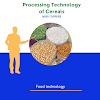MILLETS: Introduction, Production
Introduction
The name "Millet" has been derived from the word "mil or thousand" referring to the large number of grains that can be produced from a single seed. Millets may have been consumed by humans for about 7,000 years and potentially had "a pivotal role in the rise of multi-crop agriculture and settled farming societies The millets originated primarily in East and West Africa, Eurasia, India and China.
Millets are a group of highly variable small-seeded grasses, widely grown around the world as cereal crops or grains for fodder and human food. Marginal conditions of rainfall and dry zones are suitable for the growth of these crops. Since this particular kind of crops require humid and hot climate, it is grown in semi-arid regions of the world.Plenty of varieties of millets are grown in major areas of the world, enabling a number of people to get sufficient amounts of these small seeded grasses. Millets are important crops in the semiarid tropics of Asia and Africa (especially in India, Mali, Nigeria, and other African countries), with 97% of millet production in developing countries. The crop is favoured due to its productivity and short growing season under dry, high-temperature conditions. Pearl millet(bajra) is the most widely grown millet and is a very important crop in India and parts of Africa.Finger millet, proso millet, and foxtail millet are also important crop species. Finger millet is popular in East Africa and India. Foxtail and Proso millets are cultivated primarily in the Near East and China. Proso millet is also widely cultivated in the Russia Federation. Fonio and teff are grown in West Africa and Ethiopia, respectively.
Pearl millet
Pearl millet (Pennisetum glaucum L.) belongs to the family of Graminea. This grain is basically originated from India or Africa. The crop is supremely adapted to heat and aridity, and production is likely to increase as the world gets hotter and drier.It is one of the major crops of China, India, South Eastern Asia, Sudan, Pakistan, Arabia, Russia & Nigeria. Pearl millet is a coarse grain crops and considered to be the poor man’s staple nourishment and suitable to cultivate in dry lands. The grain is nutritious, and has higher protein and energy levels than maize or sorghum. It is a staple food that supplies a major proportion of calories and protein to large segments of the populations living in the semi-arid tropical regions of Africa and Asia. It is the most common type of millet crop locally known as bajra in India. This particular crop takes up about 50% of the total production of millets. Major Bajra production states in India are: Rajasthan, Maharashtra, Haryana, Uttar Pradesh and Gujarat. Bajra can also used as valuable animal fodder. Major Bajra Production States in India: Top Bajra producing state in Rajasthan followed by Maharashtra, Haryana, Gujarat and Uttar Pradesh. Top high yielding stats is Tamil Nadu.
Finger millet
Finger millet (Eleusine coracana L.) is an annual herbaceous plant widely grown as a cereal crop in the arid and semiarid areas in Africa and Asia.It is an important millet grown extensively in various regions of India and Africa and consumed as a staple food for a large segment of the population in these countries. It is grown both as grain and forage The green straw is suitable for making silage. Ragi or finger millet is the fourth largest produced millet in the world and It ranks sixth in production after wheat, rice, maize, sorghum and bajra in India.It is mostly grown and consumed in Karnataka, and to a limited extent in Andhra Pradesh, Tamil Nadu, Odisha, Maharashtra, Uttarakhand and Goa. It has different names in local languages like ragi in Kannada, Telugu and Hindi. It is a naked caryopsis with brick red-coloured seed coat and is generally used in the form of the whole meal for preparation of traditional foods, such as roti (unleavened breads or pancake), mudde (dumpling) and ambali (thin porridge). . Grains are rich in minerals and are the richest source of calcium used in many preparations like cakes,
puddings, sweet etc. It is also good for persons suffering from diabetes
Foxtail millet
Foxtail millet (Setaria italica L.) is an annual grass grown for human food. It is the second-most widely planted species of millet, and the most grown millet species in Asia. Fox tail is also known as Italian millet, and German millet. It is generally grown as a rainfed crop in India. Foxtail millet has been identified as a major millet in terms of worldwide production, as it is the sixth highest yielding grain At present, foxtail millet is cultivated in 26 countries and ranks second in world production of millets. In terms of its yielding ability, foxtail millet ranks fourth among all millets.
Other alternative names for foxtail millet include Italian millet, Italian foxtail, German millet, Siberian millet, and foxtail bristle grass.
Food utilization
Millets have been utilized for human food for prehistoric times. In India, virtually all of the pearl millet and most of the finger millet is directly consumed as human food. The most important use of pearl millet grain is in baking chapattis or rotis. Millet grain is also used for production of rice-like products and porridges. Pearl millet is also used to produce malt and alcoholic beverages. Millet flour has been successfully incorporated into cutlets, pakoras, weaning foods and biscuits















0 Comments
Send feedback